Have you got lots of people coming into your website but few actually buying your products? That’s not a good place to be (though I guess not having people come at all is certainly worse). The good news is that with people coming into your website, you’re actually in a position to figure out what you need to do to boost your sales numbers.
How do you do that? Through data analysis, of course. The people coming through your website form perfect guinea pigs for ways that you can improve your conversion rates.
A quick note about A/B testing
Note that with all the suggestions I’m going to make you should most certainly consider using A/B testing. You might be tempted to rely simply on comparing the numbers before and after you’ve made the change but when you do that you’re allowing for a lot more noise to enter into the experiment.
After all, not all referring sites are created equally. People who come through searches, for example, might be more interested in buying than those who come in through social media. But you can’t really control what channels send people to your website.
This means that by using a before and after comparison you’re allowing for a lot more noise than is necessary. A/B testing – as it happens at the same time – doesn’t have that problem. So use it.
Identify the big spenders
You might think that identifying the big spenders and giving them incentives to spend more will only give you a small boost in your sales numbers. You’d be wrong. It is commonly accepted that 20% of your customers buy 80% of your product. So really, most of your focus should be on keeping these customers happy and coming back.
For that reason, use data analytics to discover who these people are and then make sure that you offer them interesting promotions. Again, using A/B testing you can vary the promotions over time to find out which ones are the most effective.
Of course, ultimately you’ll want to make sure all of your serious customers will get the same offers. Otherwise there might be a PR disaster waiting for you down the line.
Trigger marketing
Trigger marketing is the act of identifying certain customers and giving them special offers in order to get them to spend more. The reason you want to use trigger marketing is because it means you’re offering, say, free discounts and gifts to only those customers who would otherwise stop making purchases.
A good example of a trigger marketing strategy that works well is to identify customers who previously bought several times and then stopped. By offering these people discounts you’ll manage to draw some of them back. And those you don’t – well they don’t use the discount so you haven’t spent any money on them.
Note that one of the triggers you’ll want to set up is loyalty. After all, you don’t want loyal customers to find out they aren’t getting offers that the people who aren’t as loyal are.
Chase down customers who didn’t buy
It is now incredibly easy to follow people who have come to your website when they’re no longer there. All you need is to install Pixel from Facebook, for example. With this installed it becomes incredibly easy to then advertise to those people once they’ve left your site again.
This is an incredibly effective way to boost your return rate – and as return visitors are far more likely to make a purchase the next time around, this can significantly boost your sales numbers. Even better, software like this can be aimed at specific parts of your website. Say if they’ve actually looked at your products, or they’ve come to your site through specific keywords and not just because they got there by accident.
Lookalike marketing
Carefully consider which kinds of marketing work best on one platform and then repeat them elsewhere. Here I’m not just talking about using the same picture. Instead, you want to really pull out every single bit of data that you’ve varied and focus on that.
There are a number of aspects that are important to consider.
- What are you trying to sell?
- How are you trying to sell it?
- Who are you offering it to?
- When are you offering it?
- Where are you offering it?
Make sure you create campaigns that vary on only one of these dimensions to see what works better. If you consistently and effectively vary one of these dimensions you’ll be able to see what works well and what does not. From there, you can then create campaigns that pull in the people who will actually by – and not just once.
Note that Facebook, for example, now offers you the opportunity to approach users who are very similar to the ones who have already demonstrated an interest through Lookalike audiences. But that’s hardly the only place you should try to create similarities to see what is most effective.
Push trending products
Now that you can get back real-time results about which products are doing particularly well, it is becoming easier than ever to latch onto a trend and go with it.
For that reason, you should always be monitoring what is interesting customers at a certain moment in time and to make it incredibly easy on your website to then put that winning product in the spotlight. Put it on your front page. Offer a discount on it or if it’s offered with another product. Or push it harder across social media (particularly those platforms where it has drawn the most attention).
Last words
The truth is that the internet makes all sorts of marketing possible that didn’t even exist a decade ago. Using them correctly can bring you those customers and visitors who are the most likely to actually buy your product and come back again in the future.
All it takes is to master the different technologies that are out there. And for that, once again, you’ll want to make sure you use tools like A/B testing, as they will give you a real idea what is actually working and what is not.
Because one of the biggest advantage of this age we live in is that we no longer need to rely on hunches but can instead follow the big data towards marketing success.










